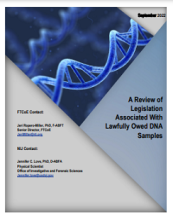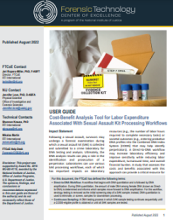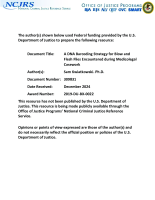Relationship Inference with Low-Coverage Whole Genome Sequencing on Forensic Samples
A tool for simulating single source and mixed DNA profiles
A genotype likelihood function for DNA mixtures
An Introduction to Forensic Genetic Genealogy Technology for Forensic Science Service Providers
A Review of Legislation Associated With Lawfully Owed DNA Samples
Use of hormone-specific antibody probes for differential labeling of contributor cell populations in trace DNA mixtures
Just Science Podcast: Just Leveraging Databases for Human Identification
Content Advisory
Some content in this podcast may be considered sensitive and may evoke emotional responses, or may not be appropriate for younger audiences.
Guiding proposition setting in forensic DNA interpretation
Just Science Podcast: Just Identifying Individuals with Forensic Genetic Genealogy
Content Advisory
Some content in this podcast may be considered sensitive and may evoke emotional responses, or may not be appropriate for younger audiences.
Cost-Benefit Analysis Tool for Labor Expenditure Associated With Sexual Assault Kit Processing Workflows
Just Science Podcast: Just Solving Cold Cases with Forensic Genetic Genealogy
Content Advisory
Some content in this podcast may be considered sensitive and may evoke emotional responses, or may not be appropriate for younger audiences.
What's Possible with Rapid DNA Technology
A DNA Barcoding Strategy for Blow and Flesh Flies Encountered during Medicolegal Casework
New Genus and Species of Black Coral from the SW Pacific and Antarctica (Cnidaria: Anthozoa: Antipatharia: Schizopathidae)
Re: Riman et al. Examining performance and likelihood ratios for two likelihood ratio systems using the PROVEDIt dataset
Technical Modifications for the Application of the Total Difference Method for Frontal Sinus Comparison
Development and validation of a novel method "SpermX (TM)" for high throughput differential extraction processing of sexual assault kits (SAKs) for DNA analysis
Investigation into the effect of mixtures comprising related people on non-donor likelihood ratios, and potential practises to mitigate providing misleading opinions
Developmental validation of a microRNA panel using quadratic discriminant analysis for the classification of seven forensically relevant body fluids
Assessing non-LUS stutter in DNA sequence data
Interpretation of Y Chromosome STRs for Missing Persons Cases
A new implementation of a semi-continuous method for DNA mixture interpretation
The Evidence We Leave Behind (Part 2)
Determining Informative Microbial Single Nucleotide Polymorphisms for Human Identification
Allele frequencies and minor contributor match statistic convergence using simulated population replicates
Research Forensic Library
We invite you to also search the Research Forensic Library, a curated collection of publicly-accessible material relating to every discipline of the forensic sciences.







